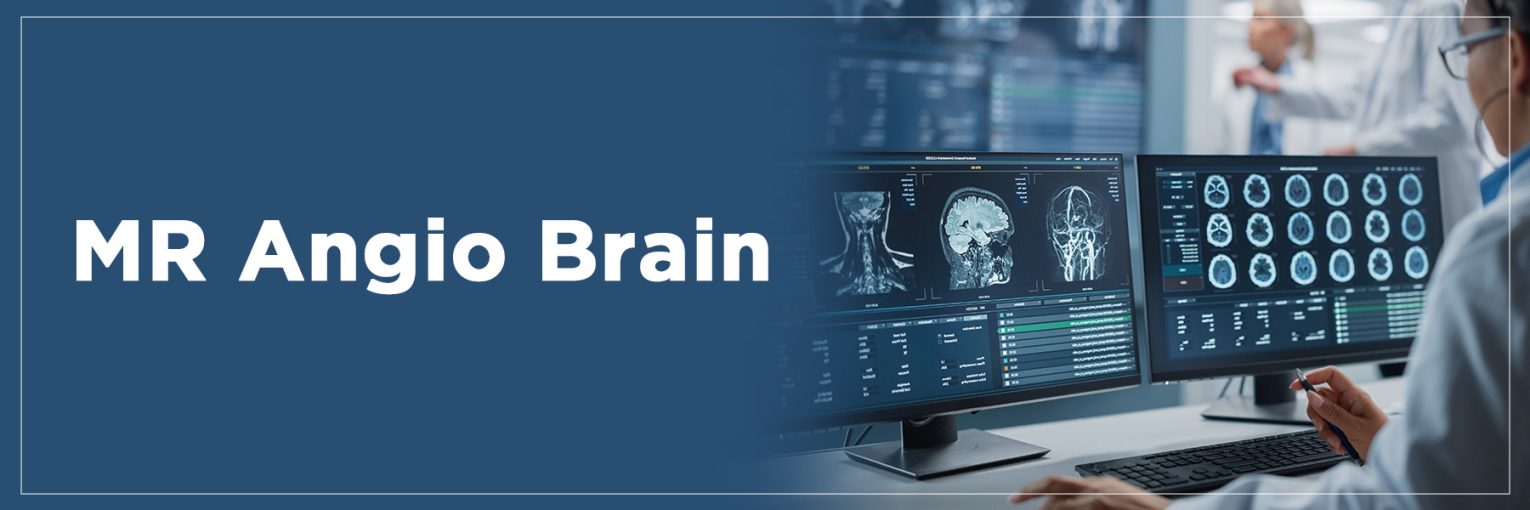MR Angio Brain is a special test that helps doctors see blood vessels in the brain. An MRI scan checks for problems like blockages, weak spots, or abnormal growths without needing surgery. This safe test uses magnets and radio waves instead of harmful X-rays. Sometimes, a dye is used to make the pictures sharper. MR Angio Brain can find serious issues like strokes or tumours early, helping doctors plan the best treatment. This article explains how it works, its benefits, its safety, and the conditions it can diagnose.
What is MR Angio Brain?
MR Angio Brain is an MRI examination that visualises brain blood vessels and has alternative names. The imaging process evaluates brain blood vessels through clear image generation, enabling medical professionals to identify vascular obstructions and irregularities without requiring standard surgical procedures.
The procedure of MR angiography differs from traditional angiography since it avoids using a body catheter and reduces patients’ pain. During the examination, you need to maintain a supine position within the extended cylindrical structure of an MRI scanner. The medical staff uses intravenous injections of safe contrast dye to increase the visibility of blood vessels after testing the patient, which involves acquiring images within an MRI scanner.
How Does MR Angio Brain Work?
Here are the steps which will help you to know how MR Angio of Brain works:
- Magnetic fields start the process: MR angio brain, also called MR Angio of the brain, uses a strong magnetic field in an MRI machine. This field aligns tiny hydrogen atoms naturally found in the body’s tissues, including brain blood vessels.
- Radio waves capture energy: During an MRI head scan, the machine sends radio waves through the head. These waves cause the hydrogen atoms to release energy as they return to their normal position.
- Images are created: A computer collects this energy and turns it into detailed pictures of brain blood vessels, showing thin slices from different angles.
- Contrast may be used: Sometimes, a special dye is injected to make blood vessels appear bright and clear in the images.
Benefits of MR Angio Brain
Below are some of the advantages of MR Angio Brain:
- Non-invasive procedure: MR angio brain offers a safe way to examine blood vessels without surgery, reducing risks and discomfort compared to traditional angiography.
- No radiation exposure: Unlike other imaging methods, brain MRI and MR angio head use magnetic fields, avoiding harmful ionising radiation for safer diagnostics.
- High-resolution imaging: MR angio brain captures detailed, three-dimensional images, helping doctors precisely spot issues like aneurysms or blockages.
- Non-contrast option: In many cases, MR angio head can be performed without contrast, minimising potential side effects for patients.
- Safer contrast material: When needed, the gadolinium contrast used in brain MRI is less likely to trigger allergic reactions than iodine-based contrasts in CT scans.
Is MR Angio Brain Safe?
The MR Angiogram of the brain operates as a secure imaging procedure because it delivers noninvasive functionality and presents limited dangers to patients. MR Angiography radiology protects patient safety because it uses no radiation, thus minimising health risks during single and multiple scans. The MR Angio of the brain generally does not require extensive procedures because the primary intervention is usually an intravenous catheter that minimally affects blood vessels.
Patients exposed to gadolinium contrast receive a lower risk of allergic response than those exposed to iodine-based contrast. Provided thorough screening procedures are implemented, the chance of developing nephrogenic systemic fibrosis remains low for patients with severe kidney issues. Safety measures of this procedure enable patients to begin their normal routines right away since they need no recovery period.
What Can MR Angio Brain Diagnose?
Here are some of the severe conditions MR Angio Brain diagnoses:
- Aneurysms: An MRI brain within an MR Angiogram can detect weakened blood vessel walls in the brain, identifying bulges that could rupture, potentially preventing life-threatening complications.
- Strokes: Brain MRI using MR Angiography radiology pinpoints blocked or narrowed arteries, helping diagnose ischemic strokes caused by reduced blood flow to brain tissue.
- Vascular malformations: MR Angio of the brain reveals abnormal connections between arteries and veins, such as arteriovenous malformations, which, if untreated, may lead to bleeding or seizures.
- Blood vessel blockages: This imaging technique spots clots or plaques in brain arteries, which is critical for addressing stroke risks or other circulatory issues.
- Tumours affecting vessels: MRI brain with MR angiogram identifies abnormal blood vessel growth linked to brain tumours, aiding in treatment planning.
FAQs
What is MR Angio Brain used for?
MR angio brain examines blood vessels in the brain, providing clear images of blood flow that help diagnose conditions like aneurysms, strokes, blockages, or vascular malformations.
Is MR Angio Brain better than a CT angiogram?
MR angio brain is often preferred because it avoids radiation, unlike CT angiograms. It’s safer for repeated scans but may take longer. The choice depends on the patient’s condition and the doctor’s recommendation.
How long does an MR Angio Brain take?
An MR Angio Brain scan typically takes 20 to 60 minutes, including time for positioning and, if needed, administering contrast dye.
Does MR Angio Brain require contrast dye?
Not always. MR Angio Brain can often be done without contrast dye, but a gadolinium-based dye may sometimes be used for more explicit images.
Can MR Angio Brain detect brain tumours?
Yes, MR Angio Brain can detect brain tumours by showing abnormal blood vessel patterns linked to them, aiding in diagnosis and treatment planning.
MRI Scan Centre
To find MRI Scan Centre near me click here.




